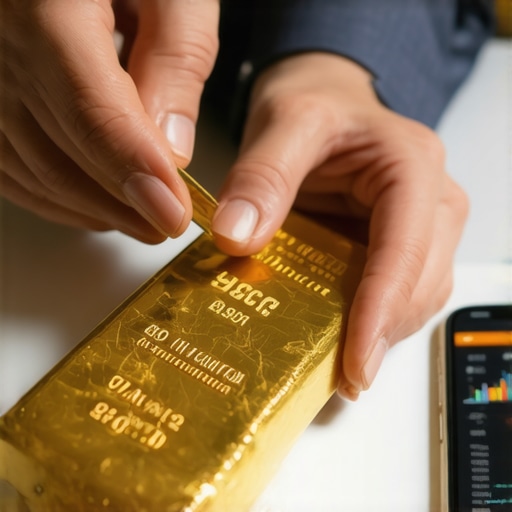Unlocking the Gold Investment Landscape: Why Gold Stocks Matter in 2024
In an era marked by economic unpredictability and fluctuating markets, gold remains a beacon of stability. For beginners eager to dip their toes into gold stocks, understanding how to balance opportunity with risk is paramount. This guide offers expert insights into buying gold stocks with low risk in 2024, drawing on market dynamics, strategic selection, and risk management techniques to empower your investment journey.
Crafting a Low-Risk Gold Stock Portfolio: The Art of Strategic Selection
Not all gold stocks are created equal. To minimize risk, investors should focus on companies with strong fundamentals, proven operational efficiency, and consistent dividend history. Mid-tier producers with diversified mining operations often present less volatility than junior explorers. For example, Barrick Gold and Newmont Corporation are established names known for resilience during market downturns. Incorporating such blue-chip stocks can anchor your portfolio against sudden shocks.
How Can Beginners Identify Gold Stocks with the Best Risk-Reward Profile?
Evaluating gold stocks involves more than glancing at current prices. Key metrics include the company’s production costs, debt levels, geopolitical risk exposure, and cash flow stability. Beginners should look for stocks with low all-in sustaining costs (AISC) and manageable debt-to-equity ratios. Additionally, tracking global gold demand trends and central bank activities can provide macroeconomic context—factors that influence stock performance profoundly. Resources like top gold mining stocks to watch offer valuable curated insights.
Risk Mitigation Techniques: Balancing Gold Stocks with Diversification and Timing
Even within gold stocks, diversification is a critical risk mitigation tool. Spreading investments across various companies, including miners, royalty firms, and ETFs, reduces exposure to company-specific risks. Timing entries by monitoring gold price forecasts and economic indicators can further shield investors from volatility. Experts often recommend gradual buying strategies to average entry prices and capitalize on market dips. Accurate gold price forecasts provide actionable data for timing decisions.
Integrating Gold Stocks into a Broader Investment Strategy for 2024
Gold stocks should complement, not replace, other asset classes in your portfolio. Their role as a hedge against inflation and currency fluctuations is well-documented. Combining gold stocks with physical gold or gold ETFs can enhance portfolio flexibility and liquidity. For beginners, understanding the differences between these investment vehicles is crucial to tailoring a low-risk approach suited to personal financial goals.
Ready to deepen your understanding and optimize your gold stock investments? Explore our detailed insights on gold stocks’ risks and rewards to make informed decisions.
Deep Dive into Gold Stock Analysis: Beyond the Basics
Seasoned investors understand that the nuances of gold stock valuation extend far beyond surface-level metrics. Beyond assessing production costs and debt ratios, analyzing a company’s reserve life, geopolitical footprint, and management quality is essential. For instance, miners operating in politically stable jurisdictions tend to offer less risk compared to those in regions with regulatory uncertainties or conflict. Moreover, leadership teams with a track record of prudent capital allocation and operational excellence often navigate downturns more effectively, preserving shareholder value.
Financial metrics like cash flow from operations versus capital expenditures provide insight into sustainability and growth potential. Investors should scrutinize quarterly earnings calls and management commentary for forward-looking guidance and risk disclosures. Such detailed due diligence helps build a comprehensive risk profile that aligns with long-term investment horizons.
Strategic Use of Gold ETFs and Royalty Companies in Risk-Adjusted Portfolios
Incorporating gold-focused Exchange Traded Funds (ETFs) and royalty companies can further refine risk management strategies. ETFs offer liquidity and broad exposure without the operational risks linked to mining companies. Meanwhile, royalty firms, which earn passive income from mining operations, typically exhibit lower volatility and higher dividend yield consistency. This hybrid approach balances growth and income, mitigating the cyclical nature of mining stocks.
Popular ETFs such as the SPDR Gold Shares (GLD) and royalty companies like Franco-Nevada have demonstrated resilience during market fluctuations. For investors seeking diversified gold exposure with manageable risk, understanding these alternatives is crucial. Comprehensive insights into gold ETFs versus mutual funds can aid in crafting a tailored investment mix.
What Role Do Macroeconomic Indicators Play in Timing Gold Stock Investments?
Macroeconomic forces such as inflation rates, interest rate trends, and currency strength significantly affect gold prices and, by extension, gold stocks. Rising inflation often drives investors toward gold as a safe haven, boosting mining stocks. Conversely, increasing real interest rates can suppress gold demand due to higher opportunity costs.
Monitoring central bank policies, especially those of the Federal Reserve, alongside geopolitical events, provides context for market timing. For example, during periods of heightened economic uncertainty or geopolitical conflict, gold stocks typically outperform other sectors. Utilizing accurate gold price forecasts alongside macroeconomic analysis enhances decision-making precision.
Practical Portfolio Construction: Combining Physical Gold and Gold Stocks
Experts often advocate a balanced portfolio that integrates physical gold holdings with gold stocks. Physical gold — in forms such as coins or bars — offers tangible asset security and zero counterparty risk, serving as an anchor during extreme market turmoil. Meanwhile, gold stocks provide leverage to gold price movements and potential dividend income, contributing growth potential.
Allocating between these assets depends on individual risk tolerance and investment objectives. Beginners should consider starting with a modest physical gold allocation before progressively increasing exposure to gold stocks and ETFs. Resources like top physical gold investment options offer detailed guidance to navigate this decision.
Investors are encouraged to share their experiences or questions about balancing gold stocks with physical gold in the comments below. Engaging with a community of informed investors can provide valuable perspectives to refine your strategy.
Harnessing Quantitative Models and AI for Gold Stock Risk Assessment
As the investment landscape grows increasingly complex, integrating quantitative models and artificial intelligence (AI) into gold stock analysis presents a powerful frontier for risk mitigation. These advanced tools synthesize vast datasets—ranging from historical price movements and production metrics to geopolitical risk indices—delivering predictive analytics that traditional methods may overlook.
Quantitative risk models can assess volatility patterns and correlations with macroeconomic indicators, enabling investors to anticipate market shifts and adjust positions proactively. AI-driven sentiment analysis of news and social media further enriches this approach by capturing market psychology nuances that influence gold stock prices. Leveraging platforms that incorporate machine learning algorithms allows investors to identify subtle signals in gold market dynamics, refining entry and exit timing for low-risk exposure.
How Do Machine Learning Algorithms Improve Accuracy in Gold Stock Forecasting Compared to Traditional Techniques?
Machine learning algorithms excel in identifying nonlinear relationships and complex interactions among variables impacting gold stocks. Unlike traditional linear regression models, these algorithms continuously learn from new data, adapting to evolving market conditions. They integrate multifactorial inputs such as commodity supply disruptions, currency fluctuations, and investor sentiment with greater precision.
For example, a 2023 study published in the Journal of Commodity Markets demonstrated that ensemble learning models outperformed classical econometric forecasts by up to 15% in predicting gold price movements, directly influencing gold stock valuations. Incorporating such models into your investment toolkit can significantly enhance risk-adjusted returns by preempting adverse market conditions.
Incorporating Environmental, Social, and Governance (ESG) Criteria to Reduce Long-Term Risk
ESG factors are increasingly critical in evaluating gold mining companies’ sustainability and risk profiles. Mining operations with robust environmental stewardship, transparent governance, and positive social impact tend to face fewer regulatory challenges and reputational risks—key considerations for long-term investors.
For instance, companies actively reducing carbon emissions and engaging constructively with indigenous communities demonstrate resilience against operational disruptions. ESG integration not only mitigates risk but also aligns your portfolio with emerging global standards and investor expectations, enhancing appeal to institutional capital and potentially stabilizing stock performance.
Platforms like the MSCI ESG Ratings provide comprehensive assessments of mining companies, enabling investors to incorporate ESG scores into their selection criteria effectively.
Advanced Hedging Techniques: Options and Futures for Gold Stock Exposure
Beyond diversification and fundamental analysis, sophisticated investors employ derivatives such as options and futures to hedge gold stock exposure. Protective put options can limit downside risk by establishing a floor price, while covered calls generate income to offset portfolio volatility. Futures contracts allow for strategic positioning in anticipated gold price movements without direct equity exposure.
These instruments require expertise and careful consideration of contract specifications, margin requirements, and timing. However, when used judiciously, they provide a dynamic layer of risk management, enabling precise tailoring of portfolio risk profiles in response to market conditions.
What Are the Best Practices for Beginners to Utilize Options in Gold Stock Risk Management Without Excessive Complexity?
For beginners, starting with simple protective puts on major gold stocks or gold ETFs can introduce hedging benefits with manageable complexity. Utilizing well-established broker platforms that offer educational resources and simulated trading environments can build confidence. Moreover, consulting with financial advisors experienced in derivatives ensures strategies align with investment goals and risk tolerance.
Resources such as the CBOE Options Institute provide authoritative tutorials tailored for investors seeking to incorporate options prudently.
Exploring these advanced strategies will deepen your mastery of gold stock investing and empower you to construct a portfolio that withstands volatility while capitalizing on growth opportunities. Stay tuned for our next section focusing on geopolitical risk analytics and their integration into gold investment strategy.
Decoding Geopolitical Impact: A New Frontier in Gold Stock Risk Analysis
In today’s interconnected world, geopolitical tensions exert profound influence on gold stock valuations. Beyond traditional metrics, investors must dissect the geopolitical landscape with surgical precision. Regions plagued by political instability, trade sanctions, or resource nationalism can dramatically shift operational risks and cost structures for mining companies. Conversely, geopolitical safe havens attract institutional capital, bolstering share price resilience.
Incorporating real-time geopolitical risk analytics platforms, such as those offered by Control Risks, equips investors with actionable intelligence to anticipate disruptions and recalibrate portfolios accordingly. This proactive approach transcends reactive investment tactics, positioning gold stock portfolios to weather volatility generated by sudden geopolitical shocks.
Behavioral Finance Insights: Navigating Investor Sentiment in Gold Markets
Investor psychology plays an often underestimated role in gold stock price dynamics. Herd behavior, overreaction to news, and cognitive biases can precipitate mispricings, presenting savvy investors with opportunistic entry points. By integrating behavioral finance frameworks with quantitative models, one can discern sentiment-driven divergences from fundamental valuations.
Sentiment indices derived from news analytics, social media trends, and market surveys complement traditional fundamentals, enabling a more nuanced interpretation of market cycles. Such dual-layered analysis aids in distinguishing transient market noise from durable investment trends, optimizing timing strategies.
How Can Advanced Geopolitical Risk Metrics Be Integrated into Gold Stock Valuation Models?
Advanced geopolitical risk metrics can be quantified using bespoke indices that assess parameters such as conflict intensity, regulatory unpredictability, and political stability scores. Integrating these metrics into discounted cash flow (DCF) models enhances the precision of future cash flow projections by adjusting discount rates or expected growth rates based on risk exposure.
For instance, a mining operation in a country with escalating political unrest may warrant a higher risk premium, thereby lowering the net present value (NPV) of its assets. Leveraging multi-factor risk-adjusted valuation frameworks, as explored in recent academic research from the Journal of International Money and Finance, supports a rigorous, data-driven approach to incorporating geopolitical considerations without sacrificing model transparency.
Augmenting Portfolio Resilience Through Dynamic Rebalancing and Risk Parity
Dynamic rebalancing techniques, underpinned by risk parity principles, enable investors to maintain optimal exposure levels amid shifting market regimes. By continuously calibrating asset weights based on volatility forecasts and correlation structures, portfolios can minimize drawdowns while capturing upside potential.
Applying this methodology to gold stocks involves adjusting allocations not only in response to gold price movements but also factoring in evolving geopolitical and macroeconomic signals. This systematic approach contrasts with static allocation strategies, reducing emotional trading and enhancing risk-adjusted returns over time.
Harnessing Cutting-Edge Data Analytics Platforms for Real-Time Decision Making
State-of-the-art data analytics platforms integrate multi-source datasets, including satellite imagery, supply chain logistics, and environmental monitoring, providing granular visibility into mining operations’ health and potential disruptions. Such insights empower investors to anticipate production issues before they affect market prices, offering a significant edge.
For example, platforms like SatImagingCorp utilize high-resolution satellite data to monitor mine site activity, enabling predictive analytics that align with investment timelines. Marrying these technological advancements with traditional financial analysis creates a robust framework for low-risk gold stock investing.
Ready to Elevate Your Gold Stock Investment Strategy?
Integrating geopolitical risk analytics, behavioral finance insights, dynamic portfolio management, and cutting-edge data technologies crafts a sophisticated, resilient approach to gold stock investing in 2024. Engage with our expert resources to refine your strategy and harness the full spectrum of advanced tools available to discerning investors.
Frequently Asked Questions (FAQ)
What are the key factors that determine the risk level of gold stocks?
The primary risk factors in gold stocks include operational costs, debt levels, geopolitical exposure, and management quality. Companies with low all-in sustaining costs (AISC), manageable debt-to-equity ratios, and operations in politically stable regions generally present lower risk. Additionally, strong cash flow, diversified mining assets, and transparent governance contribute to mitigating risk.
How can beginners effectively diversify their gold stock investments to reduce risk?
Diversification can be achieved by investing across different types of gold-related assets such as mid-tier producers, royalty companies, and gold ETFs. This spreads exposure away from company-specific risks and operational uncertainties. Complementing gold stocks with physical gold and ETFs helps balance liquidity and risk, providing a more stable portfolio foundation.
What role do macroeconomic indicators play in timing gold stock investments?
Macroeconomic indicators like inflation rates, interest rate trends, and currency fluctuations heavily influence gold prices and mining stock valuations. Rising inflation and geopolitical uncertainty typically boost gold demand, favoring gold stocks. Monitoring central bank policies and economic forecasts helps investors identify favorable entry and exit points aligned with market cycles.
How do ESG criteria contribute to lowering long-term risks in gold stock investing?
Incorporating Environmental, Social, and Governance (ESG) factors helps identify companies with sustainable mining practices, strong community relations, and transparent governance. Such companies often face fewer regulatory challenges and reputational risks, resulting in more stable long-term performance and reduced operational disruptions.
Can advanced technologies like AI and quantitative models improve gold stock investment outcomes?
Yes, AI and quantitative models process complex datasets, capturing nonlinear patterns and market signals traditional analyses may miss. They enhance forecasting accuracy for gold prices and stock movements by integrating multifactorial inputs, enabling proactive risk management and optimized timing strategies.
What are practical ways for beginners to use options for hedging gold stock risks?
Beginners should start with simple protective put options on major gold stocks or ETFs to limit downside risk. Utilizing educational resources and simulated trading platforms can build understanding while consulting financial advisors ensures alignment with personal risk tolerance and goals.
How does geopolitical risk impact gold stock valuations?
Geopolitical instability in mining jurisdictions can increase operational risks, regulatory uncertainty, and cost volatility, negatively affecting valuations. Conversely, operations in stable regions attract investment and maintain resilience. Incorporating real-time geopolitical risk analytics enables investors to anticipate disruptions and adjust portfolios accordingly.
Why combine physical gold with gold stocks in a portfolio?
Physical gold provides tangible asset security and zero counterparty risk, serving as a safe haven during extreme market stress. Gold stocks offer leveraged exposure to gold price appreciation and potential dividend income. A balanced allocation between these assets caters to both stability and growth within a comprehensive investment strategy.
How can behavioral finance insights assist in gold stock investment decisions?
Understanding investor psychology helps identify market overreactions and sentiment-driven mispricings, presenting opportunistic entry points. Combining sentiment analysis with fundamentals refines timing and reduces emotional biases, improving risk-adjusted returns.
What is dynamic rebalancing and how does it enhance a gold stock portfolio?
Dynamic rebalancing adjusts portfolio allocations based on evolving volatility and correlation patterns, maintaining risk parity. This systematic approach reduces drawdowns and leverages upside potential by continuously optimizing exposure in response to market and geopolitical shifts.
Trusted External Sources
- World Gold Council (https://www.gold.org): Provides comprehensive data on gold demand, supply, and investment trends, essential for understanding market fundamentals and macroeconomic influences.
- MSCI ESG Ratings (https://www.msci.com/our-solutions/esg-investing): Offers authoritative ESG assessments of mining companies, facilitating integration of sustainability criteria into investment decisions.
- Journal of Commodity Markets (https://www.sciencedirect.com/journal/journal-of-commodity-markets): Publishes cutting-edge research on commodity price forecasting and quantitative models, informing advanced gold stock analysis techniques.
- Control Risks (https://www.controlrisks.com/our-services/geopolitical-risk): Provides real-time geopolitical risk analytics critical for assessing operational risks and portfolio adjustments.
- SatImagingCorp (https://www.satimagingcorp.com/): Utilizes satellite data to monitor mining operations, offering unique insights into production dynamics and potential supply disruptions.
Conclusion
Navigating gold stock investments in 2024 demands a multifaceted approach balancing fundamental analysis, macroeconomic awareness, and advanced risk management. By focusing on companies with strong financial health, diversified operations, and robust ESG practices, investors can reduce exposure to volatility and geopolitical uncertainties. Leveraging technological advancements such as AI-driven forecasting, real-time geopolitical intelligence, and behavioral finance insights further refines timing and portfolio resilience. Integrating gold stocks with physical gold and diversified instruments like ETFs creates a flexible and robust investment framework tailored to varying risk tolerances.
Empowered with these expert strategies and resources, both beginners and seasoned investors can confidently pursue low-risk gold stock opportunities in the evolving market landscape. Share your thoughts, engage with our community, and explore our other expert content to continue refining your gold investment acumen.










